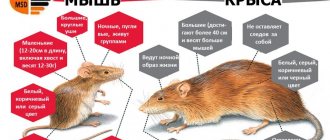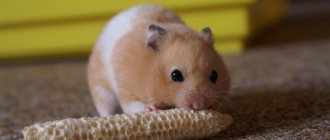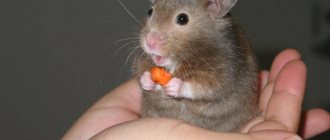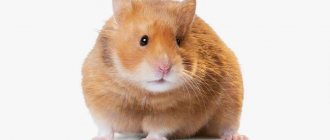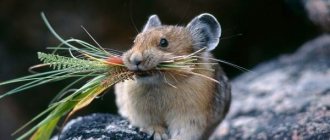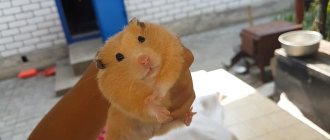Description of Campbell's hamsters
How can you describe this cute animal?
A small, furry little guy. These dwarf animals will give their owners a sea of positivity and love. It is very important to know the distinctive features of these animals. If you don’t want to make a mistake when choosing a pet, read carefully. Often people buy a pet without thinking about the breed and its inherent habits and habits. Campbells are nimble, active animals. How they are very similar to their relatives - the Dzungarians. People unfamiliar with hamster breeds are unlikely to be able to distinguish a Campbell's hamster from a dwarf hamster. But this can be done by knowing the distinguishing characteristics of the Campbell breed. Among them:
- predominance of golden, brownish or delicate amber color;
- miniature ears;
- lack of fur on the feet;
- readiness to defend one's honor in a duel (more on this later).
Housing preparation
It is recommended to buy a spacious cage, the width of which is at least 60 cm and the length of 40 cm. But these are the minimum dimensions; in a larger cage, the hamster will have more room to run around. It is better to choose models with horizontal metal rods, the distance between which should be small so that the miniature hamster does not crawl out.
You definitely need to put a small house in the cage so that the animal can rest there and also store its supplies. It is better to buy a ready-made house at a pet store, but you can make it yourself from some wooden or cardboard box; a ceramic bowl with a broken edge is also suitable, but the edge should not be sharp so that the pet does not get injured.
Sawdust or a special filler, which is sold in a pet store, should be poured into the bottom of the cage. Paper napkins are also placed in the cage so that the pet can build a nest for itself. It is not advisable to put fabric scraps, straw and newspaper, since harmful printing ink is applied to the newspaper, and the hamster can become entangled in threads and straw.
A heavy container is selected for food so that the animal does not turn it over. Water poured into a saucer quickly spills and becomes dirty, so it is better to purchase a special drinking bowl that is attached to the wall of the cage and does not spill.
When the home is fully equipped, you can go for the hamster. To transport it, use a small cage 15 cm wide and 10 cm high. The size of the cells should not exceed 1.5 cm. This cage will be useful in the future if you need to take your pet to a veterinary clinic. As a last resort, you can transport the hamster in a box made of thick cardboard with small holes, but only if the journey is not too long (no more than 90 minutes), otherwise the animal will gnaw through the wall and crawl out. If the transportation will last more than three hours, then you need to put a small slice of bread or apple in the cage so that the hamster can eat.
We invite you to familiarize yourself with Who is the Leaf Fish
Rule 1. It is better to buy a pet at a pet store or from specialists who professionally breed hamsters.
Rule 2. You need to choose healthy animals. The well-being of a pet can be judged by several signs:
- - smooth, silky and thick coat without bald spots or bald spots;
- - moderate fatness;
- - when breathing, the animal should not wheeze, cough or sniffle;
- - ears, eyes and nose are clean without any discharge or crusts;
- - the hair near the tail is free of dirt.
Rule 3. It is advisable to purchase young hamsters that are at least three and no more than seven weeks old. At this age, they already eat themselves and are quite independent. The issue of pair housing at home is controversial. Many believe that it is still better to keep them alone to avoid clashes and uncontrolled reproduction, since frequent childbirth weakens the female, and the babies can be born weak and sickly.
Appearance of Campbell's hamster
Campbell's hamsters come in one color or a variety of colors. The most common color is agouti. Take a look at this photo:
Agouti, it’s something like this (Altai type)
The coat is predominantly sandy-gray in color, the tummy is similar to the color of milk. There are animals of a monochromatic sand color. These dogs do not have a dark stripe on the back, but there are white spots throughout the fur and a light chin. This color is very popular among breeders and lovers of this breed. It's called "self".
Interesting fact : by color you can determine in which region a hamster lives.
The color of the Campbell breed hamster living in the Altai region has more gray color (see photo above), while those living in the steppes of Mongolia have more brown color with a yellowish tint. Here, for example, is a photo of a Mongolian Campbell:
Campbell's Mongolian hamster
Where there is more sand and earth, that is, the soil is brown, in the course of evolution, brownish-colored animals more often survived, since they merged with the earth. It was harder to notice them. They gave brown offspring. In Altai there are more stones and rocks, that is, more gray colors, which is why gray animals predominate there.
In addition to color, there are differences in size, ear shape, head shape and even smell. Significant differences in character. This is due to natural enemies found in the natural habitat of Campbell hamsters. For example, it is believed that animals from the Altai region are less aggressive in nature than their Mongolian counterparts.
Which hamster is suitable for a child?
Hamsters are very popular pets. Children are especially sensitive to furballs and often ask their parents to get a hamster. The animal is unpretentious, inexpensive and takes up little space in the house.
Which hamster is best for a child? Syrians are good-natured creatures. Dzungarians are wayward. Under unfavorable conditions they become mischievous and bite. But remember that the character of hamsters of the same breed is different.
Both breeds can be kept at home. But any pet needs to be properly cared for. Before getting a pet, a child must clearly understand that they need to be responsible for it.
The size of the cage depends on the size of the animal. Miniature hamsters should choose a house with closely spaced rods. Otherwise, the animals may escape. When the opportunity arises, active dwarfs will run away from the cage.
The difference between breeds is also in life expectancy. Syrian hamsters live about 2.5 years. Dzungariks are a year longer. Housing conditions affect the lifespan of animals. If you take good care of your pet and prevent the development of diseases and tumors, it will live longer.
Possible symptoms of animal illness:
- Restlessness and itching.
- Passivity and apathy.
- Discharge of mucus from the nose and watery eyes.
- Display of aggression when trying to pick up an animal.
- The presence of a tumor in a specific area of the body.
Examine your pet for the following symptoms to maintain health and prolong its life. If necessary, contact a specialist. Wooden branches, mineral or chalk stone help maintain healthy teeth.
Djungarian hamsters are quite sociable and easier to train, but it can be difficult to tame them. Syrians are flexible, non-irritable, tame creatures. For children, Syrians are a suitable option. When choosing an animal, pay attention to its character and temperament. There may be exceptions to the general rules.
Djungarians love to live together. Syrians prefer separate housing. If you put two breeds in one house, they will fight. Observe how animals live together. Both species prefer to live separately from other breeds.
Hamsters are active at night. Make sure everything they need is in their cage. Special wheels, labyrinths, a place to sleep and other “entertainment”. Change food and water daily. Rodent food can be purchased ready-made or fed with approved products.
Behavior in natural habitat
The habitat of Campbell's hamsters is the steppe regions of China, Mongolia and Russia. They are territorial (with a permanent habitat throughout their life) animals. They lead a group lifestyle. Most often, this is a pack led by a leader. Sometimes they occur in pairs. Animals know how to regulate body temperature, so they stay awake in winter. They sleep during the day and go hunting at night. They do not change color in winter. In their natural environment they behave very economically in terms of energy. They save their strength to use it at the right time. They dig holes up to 1 meter deep, laying the “floor” of the hole with grass or sometimes wool.
Breeding
Campbell's hamsters are a fast maturing breed. Rodents are already capable of procreation at 3 months.
Important! After the female turns 1 year old, it becomes more difficult for her to give birth. This is due to the gradual hardening of the bones of the skeleton.
The breeding process in Russian dwarf hamsters continues from early spring until autumn. During this time, young individuals are capable of producing up to 4 litters. For crossing, healthy individuals that are not closely related are selected. In order for the hamsters to get used to each other, they are placed in the same cage and separated by a partition, which is later removed.
After mating, the female is placed in a spacious dwelling and provided with protein food and materials for creating a nest. Pregnancy in Russian dwarf hamsters lasts about 3 weeks and ends with the appearance of 6-8 naked and helpless babies. On the fifth day, newborns begin to grow fur. And by the age of 10 days, babies’ eyes open. After the cubs are 3 weeks old, they can be moved to another cage.
Campbell's hamsters are dwarf, short-tailed rodents with a cute appearance and funny habits. And although the animals do not have a friendly disposition, they will give a lot of positive emotions to those who are interested in observing their behavior.
Distinctive features of the breed
Campbell's hamsters have the following characteristic features:
- The color is almost any color, usually close to red.
- The weight of an adult can reach up to 50 grams.
- The animal's muzzle is round, tapering towards the nose.
- It has 4 toes on the front paws and five on the hind paws.
- The average tail length is 1.4 cm.
- Body length within 10 cm.
- Eyes are black, sometimes red (in albinos)
An important distinguishing feature of Campbell's hamsters is the difficulty of taming the rodent. The animal does not like to be held and can bite strongly.
Character
Kind and affectionate hamsters
Representatives of the breeds are radically different in character. The Dzungarian small rodent is restive and aggressive. He often bites people who try to pick him up, but with proper training he becomes gentle and affectionate. The main thing is to surround him with love and care. Your pet should be tamed gradually. It is important to explain to children that a pet is not a toy.
As for his dwarf relative, he rarely shows aggression towards adults and children, so you won’t have to spend a lot of time taming him. With a little care and patience, the owner will receive an affectionate pet that can easily fall asleep in his arms.
Article on the topic: Allergy to hamsters in children and adults, symptoms
At the same time, we must not forget that each rodent has its own character, so within the same breed there are both aggressive and affectionate animals. The character of a dwarf rodent can be partially determined by its behavior in the pet store.
Differences between a Campbell's hamster and a dwarf hamster
As already mentioned, the Campbell's hamster is very similar to the Djungarian. Experienced hamster lovers and breeders can distinguish these two breeds by a number of characteristics:
- coat type;
- color;
- body type;
- ears;
- behavioral features.
Let's look briefly at each sign.
Coat type
The Djungarian hamster's fur is denser, smoother, and shiny, unlike the Campbell's hamster, which has more wavy fur, which gives it visual volume.
Color
Djungarians always have wide stripes on the sides and a thinner one on the back, extending onto the muzzle and forming a distinct diamond pattern. The Campbell is characterized by reddish colors, although pure black or white are also found.
Body type
Campbell's hamsters, unlike dwarf hamsters, boast a waist. The Djungarians have a body that resembles an egg.
Ear shape
The Dzungarik has larger and more prominent ears.
Features of behavior
The main (in my opinion) difference between Campbell's hamster and Dzungarik is character. Dzungarians are more meek and peaceful. Campbells are capable of showing aggression and sometimes even unsociability. Sometimes they are reluctant to make contact, and out of fright they can bite the owner.
Wool
The second point that is worth paying attention to is the appearance of the wool. Campbell's and Djungarian hamsters differ in the density of their fur. Dzungarik's coat is denser than his miniature relatives, smooth and even. Campbell's hamster, on the other hand, is covered in fur that gathers in clumps. The type of fur of this small rodent resembles the wool of a sheep; when the animal moves, it is divided into stripes. This difference in the appearance of the coat is due to the fact that in Dzhungarik it grows at a smaller angle to the body than in Campbell.
Care and maintenance of Campbell's hamsters at home
The Campbell's hamster is not picky about its care, but it does need to be looked after. This requires attention from the owner and compliance with a number of rules discussed below.
How to choose and arrange a cage
For a hamster, a home is an important part of his life. In its natural habitat, housing is its own fortress. The kid loves to rearrange and clean up his house in every possible way.
You need a large cage. Don't torture your little animal in vain. Hamsters are very active creatures. And even run a marathon in a big cage. Yes, there is also a wheel.
He will be very unhappy if someone disturbs his surroundings. Even if you changed the sawdust and cleaned the cage, this is extremely stressful for the hamster. Yes, cleaning is very important, but daily interference in his life is unacceptable. The only thing is that you need to remove old food and change the water on time. Owners should decide from the very beginning where the wheel and other “furniture” will be in the cage.
By the way, pay attention to the color of the cell. It was not for nothing that I chose this particular photo. In pet stores they are sold in all colors of the rainbow: red, yellow, whatever you like - everything to please customers. But there is one “BUT” - in nature, red is the color of danger. Yellow is from the same series. Why irritate your hamster once again by buying a cage of such a bright “dangerous” color. Beige or sand color is the color of his home, even if the homa was born in captivity - his natural instincts cannot be interrupted. Don’t chase such colors, you don’t want to live in a cage. Take care of your pet.
Campbell's hamster loves to wander around the house. Buying hamster ladders, labyrinths or houses will appeal to such a pet.
Character
Each individual has its own character. But, focusing on the majority of representatives of a particular variety, it is possible to determine the character inherent in the breed.
The Djungarian hamster is good-natured and friendly. It is easily tamed and, with proper training, becomes sociable. His behavior rarely shows aggression. A little affection and care - and the animal will happily fall asleep in the palms of its owner.
Article on the topic: How dangerous are hamsters for children and adults? Can you get infected from them?
The Campbell's hamster is more unsociable and can be aggressive. It is fundamentally difficult to handle and can even bite. But with the right approach, the animal will become affectionate, kind and gentle. The main thing is to surround him with care and love and he will respond in kind.
There are also opposite individuals - unsociable Dzungarians and affectionate Campbells. As a rule, the character of an animal can be determined in a pet store by observing it for a few minutes before purchasing.
What and how to feed
For breakfast, lunch and dinner, the Campbell's hamster prefers various cereals. You can buy grain mixtures at pet stores. Or you can make them yourself at home. Take corn, wheat, pumpkin seeds, sunflower seeds and other grains in equal proportions. Also, your pet’s diet must include fruits and vegetables. It could be parsley, lettuce or dill. The animal should not be given citrus fruits, as well as zucchini, spicy vegetables and potatoes, but it will happily snack on dried fruits. For variety and benefit, give bread, cottage cheese products, unsalted cereal porridge or a little boiled meat.
If you are in doubt whether you can give your hamster this or that product, take a look at our “Nutrition” section; if there is no answer there, ask it in the comments to this article. I think we can answer it.
The Campbell's hamster has a violent temperament, so it will regularly delight its owners with the sight of a stirred up bowl. Make sure that he always has something to sow in his possessions. Keep in mind that Campbells are prone to obesity and may eat more than the doctor ordered, so don't overdo it. Remember that the water must be changed daily. At least once every 2 days. The drinking bowl is washed using soda.
IMPORTANT: no detergents unless you want to poison your pet.
Conclusion
The above signs will help you easily distinguish between breeds. If the animal does not match the basic traits, this indicates crossbreeding, which is undesirable for these breeds, as it can cause mutations in subsequent generations. But crossing allows you to achieve unique, rather interesting shades of wool.
It is important to remember that, unfortunately, both breeds have a rather short life expectancy - only three years, but proper maintenance and care will give you a pet that will delight you and give you pleasant emotions.
Reproduction and pregnancy
A female Campbell's hamster can give birth between 6 and 9 weeks of age. After 6-8 months, it is better not to breed hamsters. Pregnancy lasts about 19 days. Females can give birth to up to 9 cubs at one time. Rarely less than four.
Newborn hamsters look so-so... In this photo they are already covered with a little fur, otherwise they are generally some kind of fear))
A female can become pregnant 4 times in a year. Although the Campbell's hamster understands how to reproduce correctly, it is still better for inexperienced amateurs not to breed them.
Interesting fact: a female cannot be kept in the same cage with a male - you risk losing not only the young, but also one of the hamsters during local fights over territory.
Regular childbirth can exhaust the female and hasten her death, so leave this matter to the specialists.
Sorry, but I won’t publish videos of hamster fights. If you are so bloodthirsty, you will find them yourself.
Biological characteristics
If you come to the pet store unprepared, you can easily run into problems when, instead of one type of hamster, they slip you another.
It’s even worse if you take one dzhungarik, and along with it they sell you Campbell as a pair. Under no circumstances should these species be crossed. And to avoid such problems, it is worth turning to biological signs. Both species belong to the rodents and the genus Hairfoot. Both hamsters have approximately the same size - up to 10 centimeters in length, and weigh about 70-80 grams. However, it is believed that the Campbell's hamster is a miniature dwarf hamster; its parameters in the classic form differ slightly to a lesser extent.
Both the dwarf and the Campbell are mainly nocturnal. Hamsters feed on grain crops and dried seeds, mainly pumpkin seeds.
Hamsters love to hide in holes, so there are always secret places in their house where they climb and where they store food supplies. Animals breed in captivity throughout the year; a female can give birth to up to 10 babies at a time. By the way, Djungarians bear offspring from 20 to 25 days, but Campbells carry offspring from 18 to 22 days.
Breed diseases
Campbells are vulnerable to various infectious diseases. It is a rare hamster that has never had a cold in its life. It is not recommended to treat your pet yourself. At the first signs of illness, it is better to take the animal to the veterinarian. In addition to colds, hamsters often suffer from tumors. To save the poor people from such diseases, they just need to get rid of chips, crackers and other similar products. Rodents are also prone to polycystic disease (infertility) and diabetes - melon, watermelon and other sweet fruits are prohibited.
Melon and watermelon seeds can be given in small quantities. There are a lot of useful things in them.
Recommendations for owners
Campbell's dwarf hamsters have very poor vision and perception of the world around them. Cataracts are also common in older hamsters. To compensate for this deficiency, they have many glands that are located on the face, on the cheeks, behind the ears and near the rectum.
In addition to cataracts, hamsters can develop diabetes, glaucoma and tumors (both benign and malignant). Many benign and malignant tumors can be removed surgically.
Is it possible to keep 2 or more hamsters in one cage?
A strange question, because at the beginning of the article they said that they live in flocks and pairs. So why not?
Yes, this is how it is in nature. However, in captivity, hamsters become terrible owners. By all means available to them they will win the right to their personal space. This rule also applies to Djungarians. Therefore, you can keep no more than one individual per square cell. Unless, of course, you want to feel the atmosphere of ancient Rome and watch gladiator fights.
Jokes are jokes, but for a hamster it’s a struggle for life and death. It happens that there is a fatal outcome.
Better limit yourself to one animal. These rodents can be very aggressive even after a short proximity. They may well kill their relative as a result of a fight. If you place a friend with your bandit, then try not to leave them unattended and be prepared to stop the duel.
At the end of our story, the promised photos of Campbell's hamsters.



